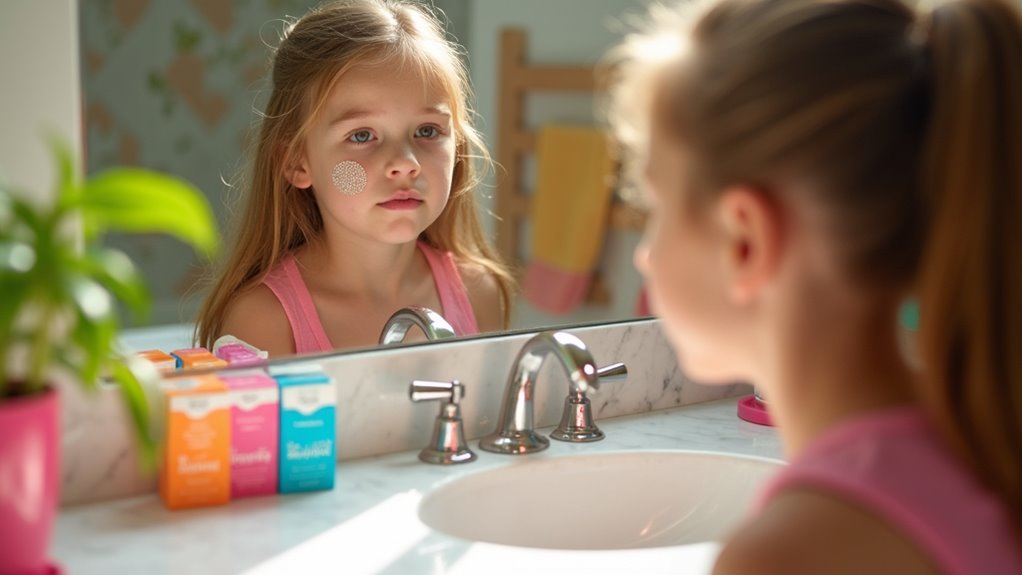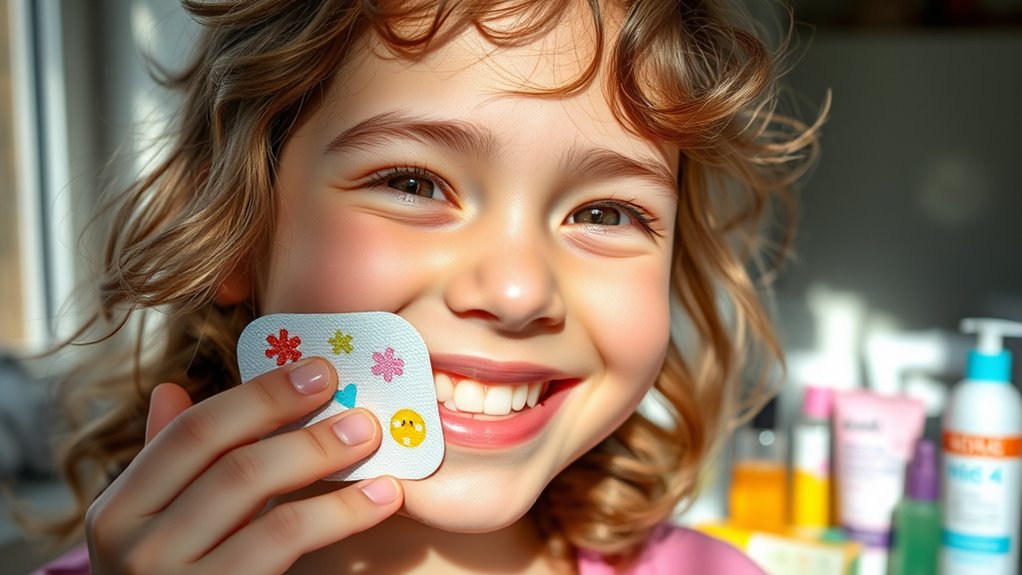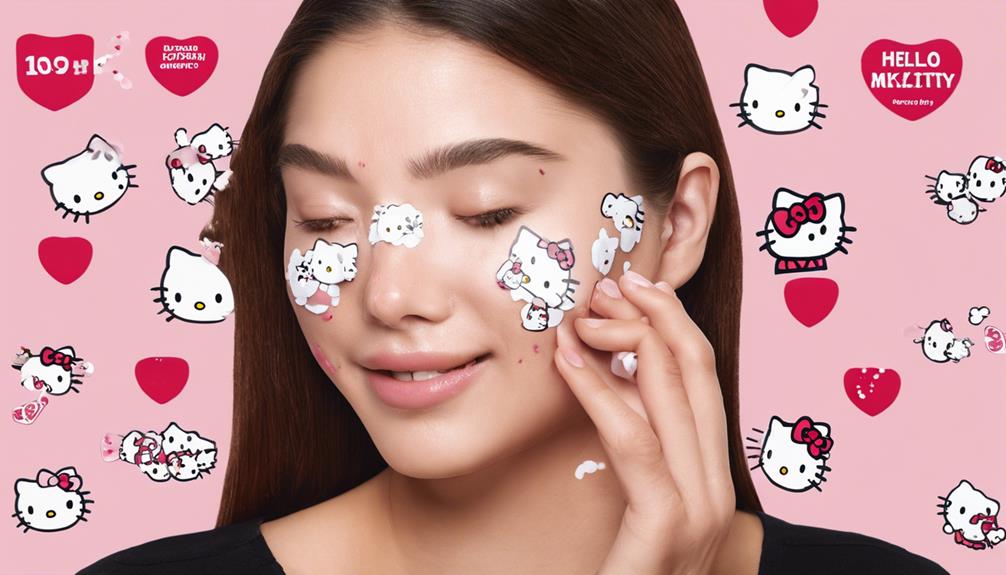If you’re dealing with teenage acne, pimple patches can be a game changer for your skin! These hydrocolloid patches absorb oil and bacteria, helping reduce redness and speed up healing. To use them, just apply on clean, dry skin over individual pimples and let them work overnight. Establishing a gentle skincare routine with a good cleanser, moisturizer, and targeted treatments is also essential. Keep exploring for more tips on managing acne effectively!
Key Takeaways
- Teenage acne affects about 85% of individuals aged 12-24, necessitating effective skincare solutions for young skin.
- Pimple patches use hydrocolloid technology to absorb impurities, making them ideal for treating individual pimples overnight.
- Establishing a consistent skincare routine with gentle cleansers and non-comedogenic moisturizers is essential for managing acne in young individuals.
- Open conversations about acne can reduce stigma and foster supportive environments for teens dealing with skin issues.
- Healthy habits, such as a balanced diet and hydration, complement acne treatments and promote clearer skin.
Understanding Teenage Acne

Understanding teenage acne is essential, especially since it affects about 85% of young people aged 12-24.
Teenage acne impacts approximately 85% of individuals aged 12-24, making understanding it crucial for effective management.
During puberty, hormonal fluctuations boost sebum production, which can clog pores and lead to acne. To effectively manage your teen skin, establishing a consistent skincare routine is vital.
Start with gentle cleansers to remove excess oil and dirt without irritation. Incorporate moisturizers to keep your skin hydrated, as dry skin can worsen acne.
For targeted treatment, consider using benzoyl peroxide or salicylic acid as spot treatments for breakouts.
Common Types of Acne in Teens

Acne comes in various forms, and recognizing the different types can help you better manage your skin during your teenage years.
Understanding these common types of acne can make a big difference in your acne treatments:
- Whiteheads: Closed comedones that slightly bulge from the skin.
- Blackheads: Open comedones caused by clogged pores that remain open at the surface.
- Papules: Inflamed red bumps formed deeper in the skin, which can turn into pustules.
- Pustules: Pus-filled bumps that can be painful and bothersome.
- Cystic Acne: Severe, painful lumps beneath the skin, often needing dermatological treatment.
The Benefits of Pimple Patches

If you’re battling breakouts, pimple patches can be a game-changer for your skincare routine. Products like Mighty Patch use hydrocolloid technology to absorb oil and bacteria, making them a smart, non-invasive option for treating acne on your teen’s skin.
These patches are designed to be worn overnight, effectively drawing out impurities and helping to reduce redness by morning. With a gentle, non-irritating formula, they’re perfect for sensitive skin types.
Designed for overnight wear, these gentle patches draw out impurities and reduce redness, making them ideal for sensitive skin.
Many users report visible results after just one use, and the discreet design offers a confidence boost for anyone feeling self-conscious about their breakouts.
Plus, at around $13 for a pack of 36, pimple patches are a budget-friendly solution for effective acne care. Additionally, incorporating antioxidant-rich foods into your diet can further support skin health and reduce inflammation.
How to Use Acne Patches Effectively

Wondering how to get the most out of your pimple patches? Follow these tips for effective use:
- Apply acne patches directly to clean, dry skin over individual pimples.
- Make certain the surrounding skin is free from creams or oils for better adherence.
- Leave the patch on for at least six hours, ideally overnight, to maximize healing.
- Replace the patch if it becomes saturated with pus, showing it’s working to draw out impurities.
- Regular use can help reduce pimple size and redness, minimizing scarring.
- For best results, consider patches that contain salicylic acid to effectively target stubborn acne.
Building a Skincare Routine for Teens

Building a skincare routine is essential for managing acne as a teen.
You’ll want to start with a gentle cleanser, a non-comedogenic moisturizer, and targeted treatments for breakouts.
Don’t forget to incorporate sunscreen during the day and follow up with your nighttime routine to keep your skin healthy.
Essential Skincare Steps
Creating a solid skincare routine is essential for managing acne-prone skin, especially during the teenage years.
Follow these essential steps to keep your skin healthy and clear:
- Use a gentle cleanser twice daily, like CeraVe Foaming Facial Cleanser.
- Apply a non-comedogenic moisturizer after cleansing to maintain hydration and support your skin barrier.
- Target individual breakouts with acne treatments such as benzoyl peroxide or salicylic acid.
- Always apply a broad-spectrum sunscreen with at least SPF 30 to protect your skin, especially since acne treatments can increase UV sensitivity.
- Guarantee consistent hydration to keep your skin balanced and resilient against breakouts.
- Additionally, consider using dilution guidelines for any essential oils you may incorporate into your skincare routine to ensure safety and effectiveness.
Daytime and Nighttime Routine
Establishing a consistent daytime and nighttime skincare routine can greatly enhance your efforts in managing acne-prone skin.
During the day, start with a gentle cleanser like CeraVe or Neutrogena to remove excess oil, followed by a non-comedogenic moisturizer and sunscreen with an SPF of 30 or higher. This protects your skin from UV damage, especially when using acne treatments that can increase sensitivity.
For your nighttime routine, cleanse again and apply an acne treatment containing salicylic acid or benzoyl peroxide, introducing these gradually to avoid irritation.
Don’t forget spot treatments like Hero Cosmetics Mighty Patch for individual breakouts; they work wonders overnight and reduce size and redness effectively.
Consistency is key!
Daytime and Nighttime Skincare Routines

When it comes to managing acne, having a solid daytime and nighttime skincare routine can make all the difference.
Follow these steps to enhance your acne management:
- Use a gentle cleanser to remove impurities.
- Apply a non-comedogenic moisturizer with SPF in the morning.
- Incorporate targeted acne treatments as needed.
- Cleanse your skin at night and use spot treatments directly on breakouts.
- Consider the Hero Cosmetics Mighty Patch for overnight use to reduce pimple size and redness.
Consistency is key!
Establishing a consistent routine is essential for achieving clear, healthy skin.
By establishing this daily skincare routine, you’ll not only maintain hydration but also improve your skin health.
Don’t forget to apply sunscreen every morning, especially if you’re using treatments that can increase sun sensitivity.
Additional Tips for Managing Acne

Maintaining a consistent skincare routine is just the beginning of effective acne management. As a teen, you should focus on gentle cleansing, using non-comedogenic moisturizers to keep your skin hydrated without clogging pores.
This is especially important when incorporating acne treatments into your routine. Always resist the urge to pick or pop pimples, as this can lead to increased inflammation and scarring. Instead, consider using hydrocolloid pimple patches to absorb impurities and prevent further irritation. Applying patches after all other skincare products can enhance their effectiveness.
Don’t forget to apply sunscreen daily, as acne medications can make your skin more sensitive to UV rays. By following these tips, you can effectively manage acne and prevent breakouts while keeping your skin healthy and glowing.
Encouraging Confidence in Young Individuals

How can you boost your confidence while dealing with acne? Building self-esteem during your teenage years can be challenging, but it’s possible! Here are some tips to help you manage your skin and feel great:
Boost your confidence while managing acne—embrace self-care and supportive conversations for a positive self-image.
- Stick to a consistent skincare routine with gentle cleansers and moisturizers.
- Use pimple patches, like the Mighty Patch, for quick relief and visible results.
- Engage in open conversations about acne to reduce stigma.
- Surround yourself with positive feedback and support from friends.
- Focus on developing healthy habits that promote clear skin.
- Consider using hydrocolloid technology in acne patches, as it can help draw out impurities and promote healing.
Frequently Asked Questions
Are Pimple Patches Ok for Kids?
Yes, pimple patches are generally safe for kids. They’re designed to target individual breakouts without causing irritation, which makes them suitable for young skin.
You’ll find that these patches help reduce redness and promote healing, often showing visible results overnight. They’re easy to apply and stay put while you sleep, so you won’t be tempted to pick at your pimples.
What Skincare Should a 10 Year Old With Acne Use?
When tackling tenacious teen acne, start with a soothing, simple cleanser like CeraVe Hydrating Facial Cleanser.
Use spot treatments like Neutrogena Rapid Clear for those pesky pimples.
Don’t forget to hydrate with a lightweight, oil-free moisturizer, such as Neutrogena Hydro Boost.
Daily defense is key, so apply a broad-spectrum sunscreen with SPF 30 or higher.
Finally, steer clear of picking—it’s a surefire way to scar your skin!
How to Treat Acne in a Young Child?
To treat acne in a young child, start with a gentle skincare routine using a mild cleanser designed for acne-prone skin.
Look for ingredients like salicylic acid or benzoyl peroxide. You can also use over-the-counter treatments, such as hydrocolloid patches, to target specific breakouts.
Educate your child about not picking at their skin to avoid scarring.
If the acne doesn’t improve, consider consulting a pediatric dermatologist for tailored advice.
How Do You Get Rid of Acne at a Young Age?
To get rid of acne at a young age, start by establishing a consistent skincare routine.
Cleanse your face gently twice daily, and don’t forget to moisturize.
Use over-the-counter treatments with salicylic acid or benzoyl peroxide to target breakouts directly.
You might also try pimple patches for individual spots.
If acne persists or worsens, consulting a dermatologist can help you find the best personalized treatment options for your skin.
Conclusion
As you navigate the ups and downs of teenage skin, remember that each pimple is just a tiny storm passing through. With the right patches, you can calm the chaos and help your skin shine like the sun after a rain shower. Embrace your skincare routine, and let each step boost your confidence. You’re not just treating acne; you’re nurturing your vibrant self, ready to face the world with a smile that lights up the room.
Claire has a knack for turning complex dermatological concepts into engaging, easy-to-understand articles. Her work primarily focuses on creating detailed reviews and thought-provoking articles in the “Vetted” category. Claire’s writing not only informs but also inspires our community to try new skincare solutions.










